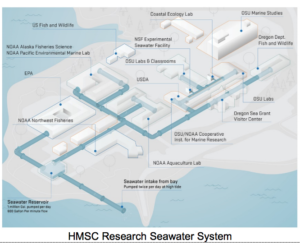
By DANA TIMS/YachatsNews.com
NEWPORT — The 50,000 people who visit the Hatfield Marine Science Center annually are introduced to all kinds of cutting-edge research, which touches on everything from aquaculture and climate change science to ocean acidification and bio-invasives.
What they don’t see, however, is the complex web of pumps and pipes that provides multiple agencies with the 1 million gallons of seawater a day needed to carry out the Oregon State University-owned center’s research mission.
That research, all reliant on salinized water identical to water found in the ocean, accounts for about $15 million worth of research annually and is critical to supporting the 450 people who work at the sprawling, 40-acre campus anchoring the southeast end of Yaquina Bay.

“Our ability to provide sufficient quantities of seawater is critical to the work done at Hatfield,” Bob Cowen, the center’s director, said in an interview with YachatsNews. “It distinguishes us from most other research facilities and has allowed us to be recognized as one of the high-quality seawater facilities in the country.”
Now, with the seawater system nearing the end of its useful life, Oregon State University’s Board of Trustees on Tuesday authorized a request to spend $5 million to completely rebuild the system’s most critical parts.
In-water work to replace the causeway that supports the electrical and piping necessary to deliver water from the main pumps to a massive holding tank twice daily is scheduled to begin in November.

Contractors will install a temporary pipeline to ensure that flows continue around the clock. Assuming no major issues arise along the way, the new system is expected to be ready by next spring.
The current system, installed in the 1970s, pumps up to one million gallons of filtered seawater daily – drawn from Yaquina Bay twice daily during high tides – to nine different buildings, Cowen said. There, it benefits research projects run by professional scientists and OSU researchers and students.
The work now being planned represents first major upgrade to the causeway, which extends out over the bay and supports the system’s four primary pumps, Cowen said.
Some of the research projects underway at the center were launched years ago, he said, adding that those efforts have put the Hatfield Center on the national and international maps in terms of prestige and scientific significance.
Recently, however, as parts of the system have begun to show signs of failure, Cowen said he worries that a more extended shutdown could be ruinous to the center’s myriad ongoing experiments.
“As a director, what keeps me sleepless at night is thinking about the state of the seawater system,” he said. “Even after several hours of shutdown, we begin to lose animals. That potential loss is highly impactful to our work.”


